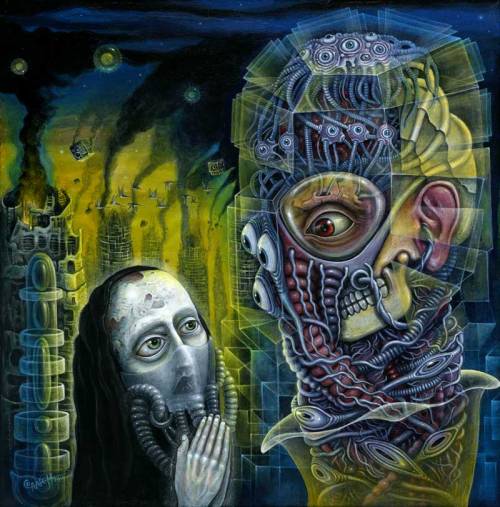#cybernetics
R.S. Connett painting titled Capilulation.
From the artist:
I believe that in the not too distant future we will accelerate the augmentation of our bodies using technology to an unprecedented degree. What began with wooden legs, hearing aids and eye glasses will become biomechanical “super-limbs”, super-vison eye implants and computer brain inseminations. I foresee surgically implanted communication devises, (Hey! I’d get one, wouldn’t you?) and … Well, only your imagination is the limit, and we all know there is no limit to the human imagination. I am one who believes that if we don’t kill ourselves in the next few decades, we will begin to push beyond Darwinian evolution. We will begin to “self-evolve” and “self-invent”. I foresee the next revolution of mankind being that of reinventing ourselves in the literal sense. We will become something all together new! I may be to old to see the day that death is “cured”, but some of you reading this now might actually live to see this.
Eventually all human beings will need to capitulate to the inevitability of our self re-design or parish. Evolution is evolution after all. :)
Post link
“Some of those Jackrabbit upgrades worry me. I think some of those guys would prefer to never take their helmet off, stay on duty a hundred percent of the time. Run and fight until there’s no steam left.”
Daily Art 141, Jackrabbit! Been a while since I visited these guys and this setting, still love ‘em!
#dailyart #myart #pencilart #sketch #classdoodles #cyborg #jackrabbit #rabbit #bunny #runner #cybernetics
https://www.instagram.com/p/Bp8vR1NHrhT/?utm_source=ig_tumblr_share&igshid=49o0knrm817c
Post link
Bootstrapping Neo-Boolean - I

(continued from here)
So yes. This is very much a work in progress. And we have strayed now as it happens into unfamiliar territory. Terra incognita. Therewill be dragons.[1] Dragons are errors. Errors are dangerous, and we must slay them. But all in good time. First, we should scout out the terrain. That would be prudent.
Descartes in constructing his system of coordinates built upon the bedrockofelementary algebra and the number line. We’vepreviously called attention to the important but mostly overlooked issue of the 1:1 congruence between number and geometric/spatial position he incorporated implicitly in the logic of his coordinates and questioned the validity of such correspondence, at least with respect to subatomic scales.
Working two centuries later but very much under the influence of Descartes’ thought, George Boole introduced his own unique brand of algebra. A second major influence on the development of his symbolic logic was the binary number system of Leibniz, himself influenced to a large degree by Descartes. We need to carefully follow and connect the dots here. Great advances in human cognition rarely, if ever, occur in isolation and seclusion. There is a fine line to tread though. If progress requires the shoulders of giants to stand on, it is still difficult at times not to be overly influenced by those who came before.
Boole’s new logic, constructed in the wake of what by his time were firmly entrenched systematizations of thought by two of the most highly regarded philosopher mathematicians, was devised in such a manner as to conform to both of these conventions of system design. Significant to our purposes here are the facts that first, Boolean logic echoes Cartesian convention of attributing to each and every location in geometric space a single unique number, and second, it adheres to Leibniz’s convention of using a modulo-2 number system based on binary elements 1 and 0.[2]
The symbolic logic systems of mandalic geometry and the I Ching do not abide by either of these conventions. Instead they are based on what is best described as composite dimensions with four unique truth values (or vector directions) each, ranging from -1 through two distinctive zeros (0a; 0b) to +1, and assignment of numbers to spatial locations through all dimensions by means of probability distributions in place of a simple and simplistic 1:1 distribution. To accommodate these alternative conceptual concepts, we will need to expand and modify traditional Boolean logic as we have already done as regards Cartesian coordinate theory.
For starters here we should doubtless add, the mandalic form is the probability distribution through all dimensions, and the probability distributions are the mandalas. And movement through either or both can only be accomplished by discretized stepwise maneuvers between different amplitudes of dimension separated by obscure quantum leaps of endless being and becoming and being and unbecoming, toward and away from the centers and subcenters of holistic systems, the parts of which are always aiming towards some kind of equilibrium never quite within reach. Which then makes error also a necessary aspect of reality and not simply the fearful monster we imagined. It is error that makes achievement possible.[3][4]
(continuedhere)
Image:Here Be Dragons Map. Detail of he Carta marina (Latin “map of the sea” or “sea map”), drawn by Olaus Magnus in 1527-39. This is the earliest map of the Nordic countries that gives details and place names, by Olaus Magnus [Public domain], via Wikimedia Commons. The map was in production for 12 years. The first copies were printed in 1539 in Venice. [Wikipedia]
Notes
[1] Mapmakers during the Age of Exploration sometimes placed the phrase “here be dragons” at the edges of their known world, presumably to warn of the dangers lying in wait for sailing vessels and travelers by land who strayed too far from well-traveled routes. Here is a list of all known historical maps on which these words appear.
[2] Or in Boole’s case, we might say, attributing to each proposition in concept space a single truth value: TRUE or FALSE (var YES or NO; or, in electronics applications, ON or OFF.) What we have here, I believe, is in many instances a false dilemma or the old Aristotelian dichotomy of either/or. Quantum physics demands and deserves better. OK, true enough, Boole gets around to extending possibilities by means of multi-term propositions, which his system can readily handle. The question here, though, is whether nature can or does handle such similarly. I think not. I think it approaches the question at a more fundamental level of reasoning and reality: at the most basic level of spacetime itself.
[3] This echoes the view of cybernetics, a transdisciplinary approach for exploring regulatory systems, their structures, constraints, and possibilities.
Cybernetics is relevant to the study of systems, such as mechanical, physical, biological, cognitive, and social systems. Cybernetics is applicable when a system being analyzed incorporates a closed signaling loop; that is, where action by the system generates some change in its environment and that change is reflected in that system in some manner (feedback) that triggers a system change, originally referred to as a “circular causal” relationship. [Wikipedia]
[4] This entire blog and its predecessor are in some sense the chronology of a journey from the familiar shoreline into largely uncharted waters. Hesitant at first, increasingly more daring as time has gone on and I’ve come to see errors to be stepping stones along the way. And there have beenmanyerrors along the way. Some I am not yet cognizant of. But of those I am aware, I have left most intact in spite of since being superseded by ideas superior, more correct or better formulated. I’ve done this because I think it important to map the course of a conceptual journey, how the ideas evolved from A to B to C to D. It also allows readers to participate, to a degree, in the thrill of an exciting adventure of mind, should they so choose. Happy travels.
© 2016 Martin Hauser
Please note: The content and/or format of this post may not be in finalized form. Reblog as a TEXT post will contain this caveat alerting readers to refer to the current version in the source blog. A LINK post will itself do the same. :)
Scroll to bottom for links to Previous / Next pages (if existent). This blog builds on what came before so the best way to follow it is chronologically. Tumblr doesn’t make that easy to do. Since the most recent page is reckoned as Page 1 the number of the actual Page 1 continually changes as new posts are added. To determine the number currently needed to locate Page 1 go to the most recent post which is here. The current total number of pages in the blog will be found at the bottom. The true Page 1 can be reached by changing the web address mandalicgeometry.tumblr.com to mandalicgeometry.tumblr.com/page/x, exchanging my current page number for x and entering. To find a different true page(p) subtract p from x+1 to get the number(n) to use. Place n in the URL instead of x (mandalicgeometry.tumblr.com/page/n) where
n = x + 1 - p. :)
-Page 303-

Hello!

O P E N Y O U R E Y E S




S Y D M E A D A E S T H E T I C



M A Y B E F U T U R E

B O D Y B U L D I N D
HORUS doesn’t exist so much as a single entity but instead burrows into the cracks and crevices of the world around it, specifically adapting to each cell’s needs. Though some push the boundaries of science and technology, most of them probably just spend all day getting angry at the omninet
Post link

.
.
.
04711020111
knop / 11korp

.
.
.
04701010111
knop / 11korp

.
.
.
04691010111
knop / 11korp

.
.
.
04681010111
knop / 11korp

.
.
.
04671010111
knop / 11korp

.
.
.
04669833111
knop / 11korp

.
.
.
04658825111
knop / 11korp

.
.
.
04648656111
knop / 11korp

.
.
.
04628128111
knop / 11korp

.
.
.
04628051111
knop / 11korp

.
.
.
04617992111
knop / 11korp

.
.
.
04607795111
knop / 11korp

.
.
.
04587593111
< knop / 11korp >

.
.
.
04587226111
knop / 11korp

___
.
.
.
04576808111
<knop>

___
.
.
.
04556333111
<knop>

___
.
.
.
04546119111
<knop>






















